After years of debate, the Conservative Jewish movement is on the verge of redefining its approach to homosexuality, a pivotal decision for a movement that occupies a shrinking middle ground between Orthodox and Reform Judaism.The word "conservative" is continuing its redefinition into meaninglessness.
Pages
▼
Thursday, November 30, 2006
Not So "Conservative" Any More?
SEE THIS ARTICLE in the Washington Post:
"Pope, Orthodox Patriarch join for Divine Liturgy"
SEE THE ARTICLE: Pope, Orthodox Patriarch join for Divine Liturgy
Nov. 30, 2006 (CWNews.com) - Pope Benedict XVI (bio - news) joined Ecumenical Patriarch Bartholomew I in celebrating the Divine Liturgy on November 30, the promise that had brought him on his 4-day visit to Turkey.
Although the papal voyage has taken on a high public profile because of controversy over Islam and Christianity, and the Turkish government's bid for membership in the European Union, the original purpose of the trip was to join the Orthodox Patriarch in celebrating the feast of St. Andrew, the patron of the Constantinople see....
In his homily during the Thursday service, Pope Benedict carefully expressed his deference toward the Constantinople patriarchate. He began by noting that St. Andrew, whose was being celebrated, was the apostle who brought his brother Simon to Jesus. And is referred to Rome and Constantinople as "sister churches." Still, later in his homily the Pope defended the primacy of Rome, observing that St. Peter traveled from Jerusalem to Antioch and then to Rome, "so that in that city he might exercise a universal responsibility." ....
Patriarch Bartholomew, in his own homily, did not directly address the practical questions of ecumenism, although he referred to the Pontiff as "our brother and bishop of the elder Rome." Instead the Orthodox prelate centered his remarks on the Divine Liturgy, and the lessons to be learned from the ceremony. "The Liturgy," he said, "teaches us to broaden our horizon and vision, to speak the language of love and communion, but also to learn that we must be with one another in spite of our differences and even divisions." ....
Wednesday, November 29, 2006
End of Indian Summer
OUR PLEASANT WEATHER will soon come to an end, with the temperature here in Saint Louis dropping fifty degrees Fahrenheit by tomorrow, with freezing rain and perhaps a foot of snow.
Bishop John Joseph Hogan, writing in the 19th century, said this about Missouri's climate:
Here are photos of the last bit of fall color: may we always remain amazed at the glory of God's handiwork. Click on any photo for a larger version. These were taken just before sunset, on November 23rd, Thanksgiving Day.













Bishop John Joseph Hogan, writing in the 19th century, said this about Missouri's climate:
INDIAN SUMMER.See this article on Indian Summer, which was also called Saint Luke's Summer.
"No climate is more delightful that the Missouri Indian Summer, usually ranging from the middle of September to the middle of November, when the blue azure sky, aglow with warm sunlight, appears mellowed and tinted by the calm autumnal haze that permeates the whole firmament, near and far away, in the immeasurable zenith and the limitless horizon. Then in the noiseless melody of nature, the little birds seem to forget their songs, the waving boughs of the forest lose their swaying motion, and the babbling brooks cease their clamor; so intent does creation seem, to enjoy its siesta, during which the human mind yields much of its turmoil to the happy hour of prevailing restfulness."
DECEIVINGLY BEAUTIFUL.
"But these soft hazy hours are not to be trusted too much, especially in the waning year, they take wings and vanish, before the bold advance of winter. The traveller on our prairies who would dream of unchanging sunshine in the latter days of November, would be apt to be rudely undeceived, as I often was in the guileless days of my youth not long since gone by...."
"Dark, blustering mid-winter in its undisguised severity, on the honest principle of forewarned and forearmed, is far less dangerous to health, than flattering autumnal sunshine. An equipment of over shoes, buck skin gloves, fur cap with ear lapels, and heavy overcoat, makes a man ironclad, against the assaults of winter."
Here are photos of the last bit of fall color: may we always remain amazed at the glory of God's handiwork. Click on any photo for a larger version. These were taken just before sunset, on November 23rd, Thanksgiving Day.













How Turks See the Pope
See these articles by the Turkish Muslim writer and columnist Mustafa Akyol:
How Turks See the Pope – Part I
How Turks See the Pope – Part I
Though this particular pope has very few fans, if any, in the 70-million-strong nation, most Turks agree with the liberals that His Holiness should be welcomed, not protested against....How Turks See the Pope – Part II
Thanks to the reports of the international fine print, many must have been informed that the fiercest opponents of the pope’s visit are Turkish nationalists. But these folks do not form a homogenous crowd. They may fit into one of three broad categories: the pure nationalists, the Islamic nationalists and the secular nationalists (aka Kemalists).
Among those Turkish nationalists who do not welcome Pope Benedict XVI, the third category would be secular nationalists, who are in line with the anti-EU forces in Turkey’s civil and military bureaucracy....And so, Turks are questioning why the Pope is visiting Turkey. I always assumed it was primarily a visit with the Ecumenical Patriarch, and this is precisely what some Turkish nationalists fear.
These crusade-phobic Turks also see a fifth column of the enemy in their very midst: the Ecumenical Patriarchate in Istanbul....
Tuesday, November 28, 2006
Photo of Monk's Mound, near Collinsville, Illinois

The Nile River in Egypt is famous for its pyramids, but the Mississippi River has its pyramids too, in particular this one, Monk's Mound, near Collinsville, Illinois. This soil pyramidal mound is about 16 acres in area and 100 feet tall. It is the largest of the Cahokia Mounds, and indeed is probably the largest prehistoric mound in the hemisphere.
This pre-Columbian city dates from ca. A.D. 1050 to A.D. 1300, and was the largest in North America. Although scholars have various theories of the city's demise, usually related to overpopulation, none mention that human sacrifice may be the reason for the fall. Also, the area is in the American Bottom floodplain: one major flood could make the area unlivable. No written or oral history exists of this city's fate.
The mound gets its name from a Cistercian Order of Strict Observance (Trappist) monastery built there in 1809. Eighty monks from La Trappe, France, made their home on 400 acres on and around the mound. The monks left in 1814 after epidemics of malaria and typhoid fever killed about half of their community; the survivors moved back to France.
Other early travelers noted that this swampland was unhealthy, yet excellent for agriculture. Since that time, these wetlands have been aggressively drained with numerous canals, and protected from the Mississippi with high levees. This region now hosts the smokestack industries in the Saint Louis metropolitan area.

Downtown Saint Louis, Missouri, about eight miles away, as seen from the top of the mound.
Photos taken in March, 2006.
Dec 9 - Catholic Lecture Series with Fr Eugene Morris, Dr Kenneth Howell
Found at AMDG:
(The Catholic Lecture Series is the 2nd Saturday of each month)
Date: Saturday, December 9, 2006
Time: 8:30 a.m.-12:30 p.m.
Holy Mass - 11 :30 a.m.
Where: Old St. Ferdinand Shrine
1 Rue Saint Francois
Florissant, Missouri 63031
Rev. C. Eugene Morris is the Director of Worship for Kenrick-Glennon Seminary and Assistant Professor of Sacramental Theology....
Dr. Kenneth Howell is Director and Fellow at The John Henry Newman Institute of Catholic Thought and Adjunct Associate Professor in the Program for the Study of Religion at the University of Illinois at Urbana -Champaign, where he teaches classes on the history, theology and philosophy of Catholicism....
Novena starts tomorrow night
Don't forget: the Novena to the Immaculate Conception starts Wednesday at Saint Francis de Sales Oratory.
Sunday, November 26, 2006
Photos of Saint Francis Borgia Church, in Washington, Missouri
HERE ARE PHOTOS of Saint Francis Borgia Church, in Washington, Missouri, of the Archdiocese of Saint Louis.
The church is about 52 highway miles west of downtown Saint Louis, Missouri, and is located on the south bank of the Missouri River in Franklin County. The city is named after George Washington, Father of the Country, and the county is named after fellow Founding Father, Benjamin Franklin.
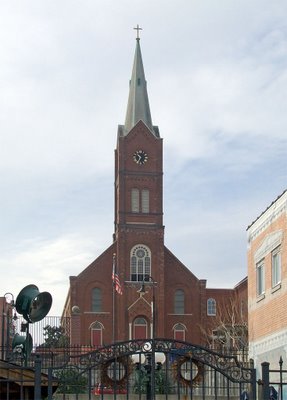
This church dates from 1869.
The first German Catholic settlers came to the area in 1833, and were first ministered to by Jesuits from Saint Charles, Missouri, located down-river from Washington. Their first church, a log cabin, was dedicated in 1834. Members of the Society of Jesus mainly ministered to the parish until 1894. From then until 1990, the parish was operated by members of the Order of Friars Minor.
Click for a history of the parish.
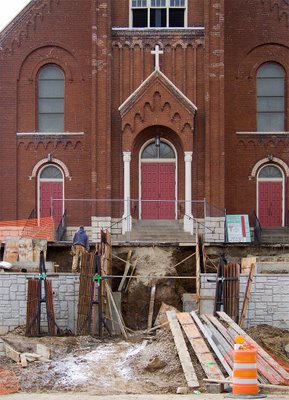
Watch your step. The parish has experienced growth and new construction throughout its history; here workmen have demolished the old steps leading up to the main church door.
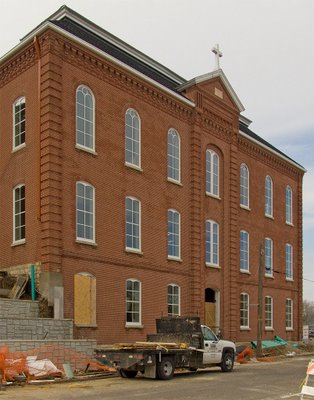
This building next to the church has been gutted and seems that it will serve, in part, as a large new narthex into the church.

Under construction. The back of the annex appears to be completely new, and will be joined to the church by a wide hall.
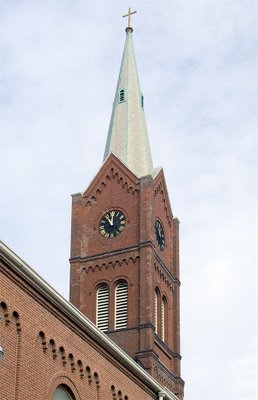
Although Washington as a city dates from 1839, European settlement here predates the town by decades. For a while, this was the westernmost city in the United States.
Here at one time was Saint John's Settlement, on the bank of Saint Johns Creek. Nearby was the Spanish colonial fort San Juan del Misuri, dating from about 1796; if any reader shares with us the precise location of the old fort, they will win great praise!
Much early settlement was encouraged by frontiersman Daniel Boone and his family, under the authority of the Spanish Empire, with the first settlers being mainly Southerners and slave owners. These Americans were overwhelmed by German immigration here in the 1840s and 1850s, which decisively swung Missouri over to the side of the Union during the American Civil War.
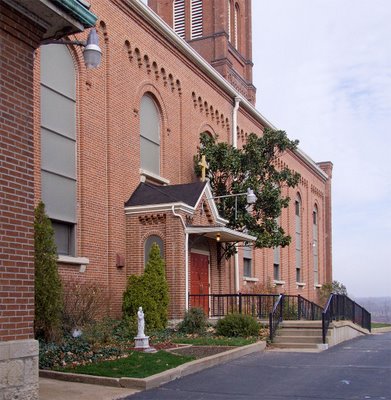
Entrance to the church is now from the side. In the far background you can see trees on the opposite side of the Missouri River.

The nave of the church. The interior has been renovated on several occasions; this generally dates from 1965.

Painting over the altar.
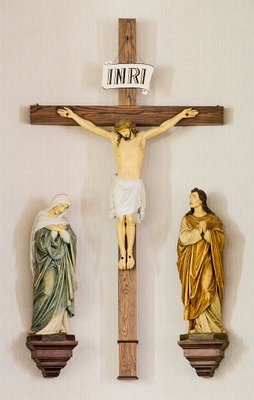
The crucifix.

The tabernacle.

Detail on ceiling.
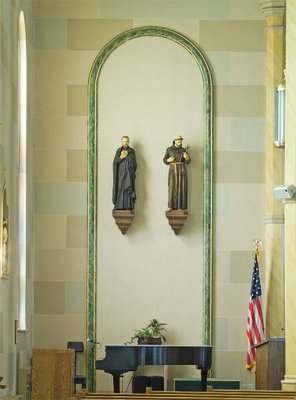
To the left of the altar we have two Saints; perhaps most fittingly a Jesuit and a Franciscan.
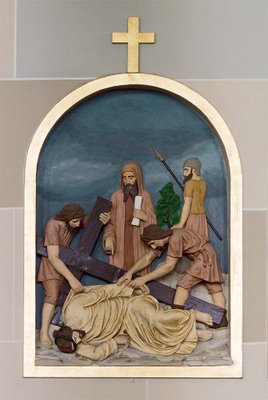
Station of the Cross

A stained glass window with the Assumption of Mary.
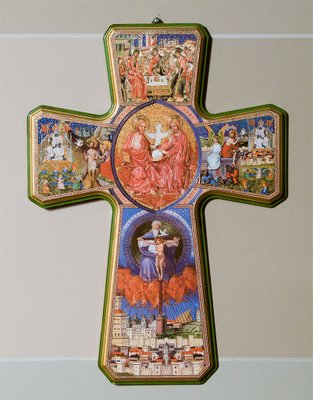
Richly illustrated cross.
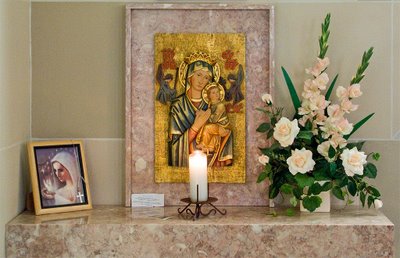
Shrine to the Blessed Virgin Mary.
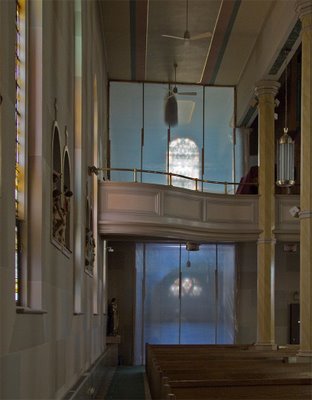
Construction is underway in the back of the church; this will probably be the entrance to the new narthex.
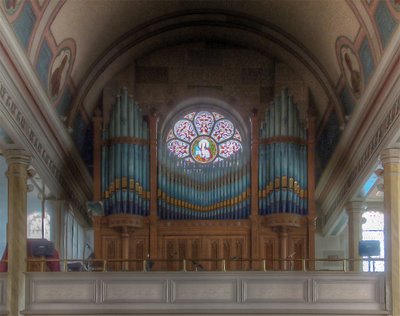
The pipe organ in the choir loft, with the rose window in the background.
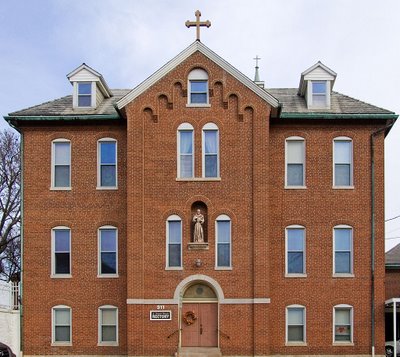
The rectory.
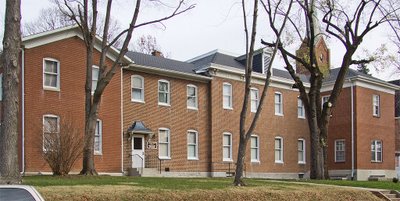
Another building belonging to church; this one obviously has been enlarged several times. The parish also owned a hospital at one time.
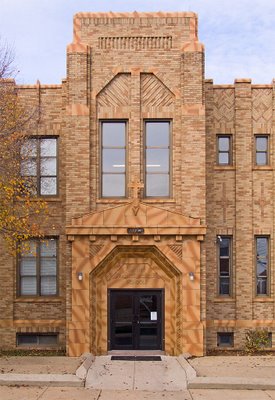
This Art-Deco school building dates from 1935.

Saint Francis Borgia was a revered Spanish Saint and Jesuit, who restored his family's name to honor after the shameful life of his great-grandfather, Pope Alexander VI.
Address:
310 West Main Street
Washington, Missouri 63090
The church is about 52 highway miles west of downtown Saint Louis, Missouri, and is located on the south bank of the Missouri River in Franklin County. The city is named after George Washington, Father of the Country, and the county is named after fellow Founding Father, Benjamin Franklin.

This church dates from 1869.
The first German Catholic settlers came to the area in 1833, and were first ministered to by Jesuits from Saint Charles, Missouri, located down-river from Washington. Their first church, a log cabin, was dedicated in 1834. Members of the Society of Jesus mainly ministered to the parish until 1894. From then until 1990, the parish was operated by members of the Order of Friars Minor.
Click for a history of the parish.

Watch your step. The parish has experienced growth and new construction throughout its history; here workmen have demolished the old steps leading up to the main church door.

This building next to the church has been gutted and seems that it will serve, in part, as a large new narthex into the church.

Under construction. The back of the annex appears to be completely new, and will be joined to the church by a wide hall.

Although Washington as a city dates from 1839, European settlement here predates the town by decades. For a while, this was the westernmost city in the United States.
Here at one time was Saint John's Settlement, on the bank of Saint Johns Creek. Nearby was the Spanish colonial fort San Juan del Misuri, dating from about 1796; if any reader shares with us the precise location of the old fort, they will win great praise!
Much early settlement was encouraged by frontiersman Daniel Boone and his family, under the authority of the Spanish Empire, with the first settlers being mainly Southerners and slave owners. These Americans were overwhelmed by German immigration here in the 1840s and 1850s, which decisively swung Missouri over to the side of the Union during the American Civil War.

Entrance to the church is now from the side. In the far background you can see trees on the opposite side of the Missouri River.

The nave of the church. The interior has been renovated on several occasions; this generally dates from 1965.

Painting over the altar.

The crucifix.

The tabernacle.

Detail on ceiling.

To the left of the altar we have two Saints; perhaps most fittingly a Jesuit and a Franciscan.

Station of the Cross

A stained glass window with the Assumption of Mary.

Richly illustrated cross.
Shrine to the Blessed Virgin Mary.

Construction is underway in the back of the church; this will probably be the entrance to the new narthex.

The pipe organ in the choir loft, with the rose window in the background.

The rectory.

Another building belonging to church; this one obviously has been enlarged several times. The parish also owned a hospital at one time.

This Art-Deco school building dates from 1935.

Saint Francis Borgia was a revered Spanish Saint and Jesuit, who restored his family's name to honor after the shameful life of his great-grandfather, Pope Alexander VI.
Address:
310 West Main Street
Washington, Missouri 63090
Oratory to Present Architectural Conference on December 17th

From the Saint Francis de Sales Oratory bulletin (links added):
The Institute of Christ the King
PRESENTS
The Historical Patrimony and
Architectural Beauty of
Saint Francis de Sales Oratory
a conference by classical architect William C. Heyer on
Sunday, December 17th, 2006
at 11:30 am
at
Saint Francis de Sales Oratory
1653 Ohio Avenue
Saint Louis, Missouri 63118Saint Francis de Sales Oratory, located in South Saint Louis, MO, was established in 1868, and is still a treasured gemstone in the Archdiocese of Saint Louis. Built in 1908, it formerly served as the church for the auxiliary bishop of the archdiocese. because it is the second largest church in saint Louis, it is given the nickname "the Cathedral of South Saint Louis". This beautiful Neo-Gothic church, currently run by the Institute of Christ the King, is attracting hundreds of people and more and more faithful attend the beautiful liturgies the church holds.
Mr. William C. Heyer is the architect assigned to the restoration of the Shrine of Christ the King Sovereign Priest. He graduated summa cum laude from Pratt Institute in New York City, and after apprenticing with Thomas Gordon Smith, founder of the classical architecture program at the University of Notre Dame, obtained his Master's degree from the same university, having conducted part of his graduate work in Rome. He has worked in classical studios in New York City, Washington D.C., and in 2002 founded his own classical architecture studies in Columbus. Mr Heyer has published in Sacred Architecture Journal, Period Home Magazine, Culture Wars magazine, as well as The Latin Mass magazine. He is chairman of Una Voce Columbus.The conference will be followed by a reception in the church basement
For more information and to register please call 314-771-3100
Private Parking is available at the Rectory
Institute of Christ the King Sovereign Priest
WWW.INSTITUTE-CHRIST-KING.ORG
Wednesday, November 22, 2006
Kenrick-Glennon Seminary Podcast
The Kenrick-Glennon Seminary in the Archdiocese of Saint Louis has a new podcast: http://www.kenrick.edu/podcast
There are two episodes so far, both of which feature Cardinal Arinzé of Nigeria, talking to the priests and the seminarians of the Archdiocese, with extensive question-and-answer periods. His talks are straightforward, and when talking to the seminarians, is often humorous. He is Prefect of the Congregation for Divine Worship and the Discipline of the Sacraments.
There are two episodes so far, both of which feature Cardinal Arinzé of Nigeria, talking to the priests and the seminarians of the Archdiocese, with extensive question-and-answer periods. His talks are straightforward, and when talking to the seminarians, is often humorous. He is Prefect of the Congregation for Divine Worship and the Discipline of the Sacraments.
Thanksgiving Blessings
From the readings of the Mass for Thanksgiving Day in the United States:
May everyone have a happy Thanksgiving!
And now, bless the God of all,—Sirach 50:22-24
who has done wondrous things on earth;
Who fosters people’s growth from their mother’s womb,
and fashions them according to his will!
May he grant you joy of heart
and may peace abide among you;
May his goodness toward us endure in Israel
to deliver us in our days.
I will give thanks to you, O LORD, with all of my heart,—Psalm 138:1-2a, 2bc-3, 4-5
for you have heard the words of my mouth;
in the presence of the angels I will sing your praise;
I will worship at your holy temple.
I will give thanks to your name,
Because of your kindness and your truth.
When I called, you answered me;
you built up strength within me.
All the kings of the earth shall give thanks to you, O LORD,
when they hear the words of your mouth;
And they shall sing of the ways of the LORD:
“Great is the glory of the LORD.”
May everyone have a happy Thanksgiving!
"Ardent advocates of eugenics"
SEE THE ARTICLE by Hilary White at LifeSite:
Anti-Religion Extremist Dawkins Advocates Eugenics
Says Nazi regime’s genocidal project “may not be bad”
Anti-Religion Extremist Dawkins Advocates Eugenics
Says Nazi regime’s genocidal project “may not be bad”
“I wonder whether, some 60 years after Hitler’s death, we might at least venture to ask what the moral difference is between breeding for musical ability and forcing a child to take music lessons. Or why it is acceptable to train fast runners and high jumpers but not to breed them,” Dawkins wrote Sunday.Mr. Dawkins forgets that even child prodigies are forced to take music lessons too. But I'm going to take a shotgun approach to eugenics and see how many holes I can poke into the argument, via these rhetorical questions:
- Suppose you do breed athletes, and they win all of the gold medals at the Olympics. That would be as fun to watch as the Saint Louis Cardinals playing against a Little League baseball team. The Cards would either win big and the Little Leaguers would go home crying; or the Cards would be nice and lose on purpose. A game like that would be interesting to watch maybe once every couple of decades.
- Suppose you do breed a number of high jumpers, and the market for high jumping just isn't what you expected it to be. For example, maybe the Olympics are canceled because genetic engineering makes the games boring. What do you do with all of the unneeded high jumpers? And if you suggest euthanasia as a solution, then what if society needs fewer college professors: should they be euthanized too?
- Genetically-modified athletes would only be interesting if they compete against each other, so like in many sports you would have a large number of classes. Boxers always fight within a specific weight class, otherwise the bigger boxer would almost certainly win, making it a dull competition. Ultimately, the only fair competition would then be between those athletes who have exactly the same kind of genetic modification. The winner in this kind of closely-matched competition would be the one with the best motivation, training, and virtue: which are all attributes of the spirit, or soul, and not the body.
- People love an underdog. The player with inferior physical attributes who wins through guts and determination is admired far more than the big guy. But if you then claim that you will breed super-athletes just to provide extra motivation for us normals, then please don't do us any favors: this is like the computer hackers who claim to be doing a favor by breaking and entering into computer systems and thereby pointing out flaws in security.
- Children look up to star athletes as heroes, and attempt to emulate them; with genetically-modified players, most children would never be able to use them as role-models.
- So will you breed people specifically for high-jumping only? What about their other attributes? Will they have good personalities, will they be sociable, will they be able to feed themselves, or hold down any other job besides high-jumping? Will your high jumpers have to be kept in cages, or under sedation when not competing? Will someone have to change their diapers?
- Don't forget that breeding high-jumpers will require hundreds, or maybe thousands of individuals in your breeding program, and the vast majority of those will not be suitable for competition; what will you do with them?
- We've been breeding animals probably for as long as there have been people. Experience shows that pure-bred animals are more susceptible, not less, to genetic diseases. A potential cat owner would be wise to choose a tabby instead of a pure breed to avoid problems. Optimizing a breed for a specific trait always uses inbreeding, which experience shows leads to undesirable genetic traits. Eugenics programs usually claim to want to both reduce genetic disease, while also improve specific attributes: these may be conflicting requirements.
- Since most dogs could easily kill their owners, they have to be bred for good temperament, which may make them less optimal for their task. But humans are far more deadly than dogs: will your human breeds have good temperaments, or will that be less than optimal for you? Would you trade good temperament for high-jumping ability? If your jumpers are violent, how will you control them, or will you claim that they are exceptional and therefore immune from the law? Will the law exist only to keep us sheep from getting in the way of the supermen?
- Who is going to raise and educate these genetically-modified children? Families or institutions? Will their education be general, or be mainly limited to their specific genetic programming? How will you then deal with large numbers of those ignorant, narrow-minded genetically-modified people?
- What do you think is the greatest good? Can you say, and how does eugenics and forced breeding help attain this? And if you say that life has no meaning, they why are you proposing such a major program of eugenics? Are you only interested in power?
- People have been breeding themselves all throughout time. Every society has rules of breeding which are more or less similar to each other, which ought to give you pause. Large numbers of generations of experience should mean something, especially to an evolutionist like Dawkins. In virtually all societies, breeding is endorsed strictly within the context of marriage, which typically has to have the agreement of the families, both mates, and the authorities who preserve the society's ancient wisdom. Each mate judges the other on attractiveness and chemistry (we don't know what it is, but we know when we have it), the families and friends judge the true personality, health, and individual virtue of each mate, and the religious authority applies other potentially crucial objective criteria to a match. Considering that we have so many human minds and institutional memory working cooperatively in such mate selection, I would think that this kind of breeding would be far more optimal for producing good humans than merely breeding for specific traits. There is certainly far more knowledge, carefully nuanced, in this kind of breeding system than what we are able to quantify scientifically.
- How are you proposing to do this kind of breeding? How much force are you prepared to use to enforce your breeding rules? How much force are you willing to use against those who strongly oppose your system? Will the benefits of creating new races of supermen outweigh the negatives of a using so much force?
- What will happen to us normals? Will we have second- or third-rate status, or be declared non-persons? Will you be embarrassed when a normal exceeds a genetically engineered superman, and will you attempt to suppress or denigrate the knowledge of this loss for your side? Will government and industry be dominated by specially-bred supermen? By law?
- Who is going to pay for such breeding? Obviously it will be very expensive. Who will get to reap the direct benefits of this breeding?
- Proposals such as these come from the same folks who advocate free love. Eugenics and free love together means universal forced contraception, sterilization, abortion, and infanticide, since free love usually leads to poor and unstable mating choices.
- Dawkins claims that humans have no souls, but he does not know about the Catholic view of the soul that derives from Aristotle, with the soul being the form, or design, of the body. This view is far richer than the mere "ghost in the machine" view that he must be thinking of.
- Do you think that you can create a Utopia with genetic breeding, and that suffering will go away? Or will this system, in fact, increase suffering due to ignorance of the psyche?
- The eugenic kind of breeding would be increasingly centralized, and any mistakes made will be very, very big mistakes, which could afflict an entire generation. Keeping breeding decisions local, as under the current system, will limit breeding mistakes to only small segments of the population.
- Who will decide what traits should be bred? Will they be racist, nationalist, or biased in any way? Consider the possibility that China may dominate the world this century, and that they consider Europeans to be genetically inferior.
- What exactly is a disease? For example, is ADHD actually a disease, or is it mainly an attribute of boys that tends to annoy female schoolteachers? Just how broad will you define "disease": will it get so big that you are forced to breed only a very small number of "good" genes, causing the equivalent of inbreeding? Or, will you specifically breed a gene that is known to cause disease, just because it also produces a desirable attribute? And sometimes there are fuzzy areas, like sickle-cell anemia which helps prevent malaria.
- Describe a "better" human being. I bet that it isn't the same as my definition. And if you claim that we all have a right to define "better" for ourselves, then how can you justify a forced genetic breeding system?
- Fictional depictions of this kind of genetic engineering are usually overwhelmingly negative. Try to take into account the wisdom of the artistic imagination.
Tuesday, November 21, 2006
More Fall Colors
THIS HAS BEEN one of the longest fall color seasons that I can remember: what was predicted to be a poor color showing was surprisingly reversed and extended by rain and mild weather. The leaves on the tallest trees have now either fallen, or in the case of some oaks, just turned brown, while the leaves on the understory trees are now mainly a yellowish green. After having spent the last two days raking leaves, I thought that I might offer these photos:
The following photos were taken on All Saint's Eve:













The following were taken on November 9th:





The following photos were taken on November 13th:




November 17th:




But this wisteria still hadn't changed color as of yesterday

The following photos were taken on All Saint's Eve:













The following were taken on November 9th:





The following photos were taken on November 13th:




November 17th:




But this wisteria still hadn't changed color as of yesterday


